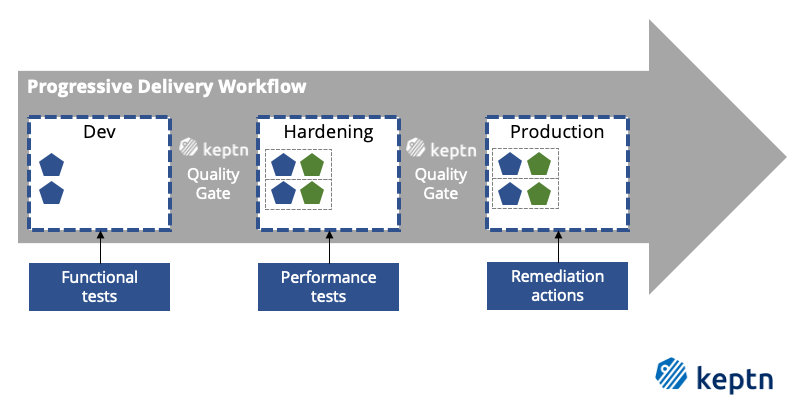Declarative Multi-Stage Delivery
Challenge: Today, many organizations build their continuous delivery workflows by hand and in an imperative way. This can lead to a lot of manual work when a scripted delivery pipeline - with slight modifications - is spread across the organization and re-used by different teams. Just imagine the difficulty to keep all variations of this pipeline up-to-date and to consider future changes in the delivery workflow of a new artifact.
Keptn allows to declaratively define multi-stage delivery workflows by defining what needs to be done. How to achieve this delivery workflow is then left to other components and also here Keptn provides deployment services, which allow you to setup a multi-stage delivery workflow without a single line of pipeline code.
Shipyard for Delivery Declaration
The definition is manifested in a so-called shipyard file that defines a delivery workflow. It can hold multiple stages, each with a dedicated deployment strategy, test strategy, as well as a remediation strategy. Following this declarative approach, there is no need to write imperative pipeline code. Keptn takes the shipyard file and creates a multi-stage workflow each stage having a deployment strategy (e.g., blue/green), testing strategy (e.g., functional tests or performance tests), and an optional automated remediation strategy for triggering self-healing actions. To learn more about a shipyard configuration, please continue here.
Please take a look at an example of a multi-stage delivery workflow with a dev, hardening, and production stage with blue/green deployment and automated problem remediation.
stages:
- name: "dev"
deployment_strategy: "direct"
test_strategy: "functional"
- name: "hardening"
deployment_strategy: "blue_green_service"
test_strategy: "performance"
- name: "production"
deployment_strategy: "blue_green_service"
remediation_strategy: "automated"
According to the example, Keptn performs a direct deployment (i.e., replacing the previous version of a microservice with a new one) and triggers functional tests in the dev stage. In the hardening stage, Keptn performs a blue/green deployment (i.e., having two deployments at the same time but routing the traffic to only one) and triggers performance tests. Finally, the production stage even defines an automated remediation strategy to trigger counter actions to any issues detected by a monitoring system.


